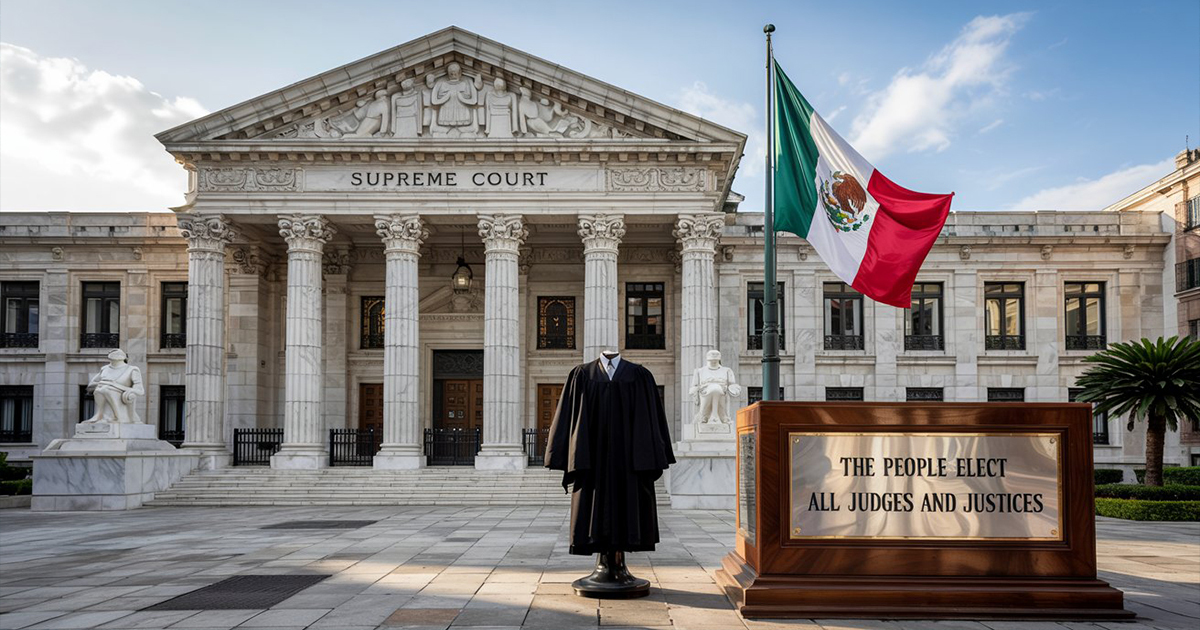Mexico held its first judicial reform elections, U.S. and Canada oppose the new policy shift

Mexico’s judicial reform, enacted on September 15, 2024, marked a significant shift in the nation’s legal landscape by introducing the popular election of all judges, including Supreme Court justices. This move positioned Mexico as a pioneer in judicial democratization, allowing citizens direct influence over the judiciary—a departure from the traditional appointment-based system. The reform was part of a broader agenda by former President Andrés Manuel López Obrador, who sought to enhance Mexican sovereignty and reduce foreign influence in key sectors.
Historical Context and Evolution of Mexico’s Judiciary
Mexico’s judiciary has long been a battleground for influence, with historical instances where U.S. interests found sympathetic rulings to protect business interests or block nationalist policies. This dynamic dates back to neoliberal reforms in the 1980s and 1990s, during which Mexico privatized state industries and opened markets under pressure from the U.S. and international financial institutions like the IMF. Critics argue that these policies increased inequality and fueled violence by drug trafficking organizations. (ukraine.wilsoncenter.org)
The U.S. has used the war on drugs as a pretext to intervene in Mexico, with a 2000 Mexican Defense Ministry document revealing that anti-drug operations were often covers for counter-insurgency efforts to suppress dissent against neoliberal reforms. (ukraine.wilsoncenter.org)
Former Chief Justice Arturo Zaldívar proposed a comprehensive judicial reform in 2021 to combat corruption, including the sale of confidential information and cheating in judicial selection processes. However, this proposal faced resistance from within the judiciary itself. (ukraine.wilsoncenter.org)
Canada has expressed significant concerns regarding Mexico’s proposed judicial reforms, particularly the plan to allow the popular election of judges, including Supreme Court justices. Canadian Ambassador to Mexico, Graeme Clark, highlighted that investors are apprehensive about the potential instability such reforms could introduce into Mexico’s legal system. He emphasized that investors seek a stable and effective judiciary to ensure the protection of their interests and the enforcement of contracts. (mexicobusiness.news)
Furthermore, Canada’s apprehension is rooted in the potential implications for the United States-Mexico-Canada Agreement (USMCA). Ambassador Clark noted that the proposed judicial changes could jeopardize the historic commercial relationship between Canada and Mexico, which relies on trust and a stable legal framework. The uncertainty surrounding the reforms has raised alarms about the future of trade and investment between the two nations. (pulsenewsmexico.com)
The 2024 Judicial Reform: Objectives and Provisions
By enabling citizens to choose judges, the 2024 reform sought to democratize the judiciary, lowering corruption and boosting accountability. Key provisions included:
- Popular Election of Judges: All federal judges, including Supreme Court justices, would be elected by popular vote, with each serving a renewable nine-year term. (insightplus.bakermckenzie.com)
- Reduction in Supreme Court Justices: The number of Supreme Court justices was reduced from eleven to nine, with terms limited to twelve years. (insightplus.bakermckenzie.com)
- Establishment of New Judicial Bodies: The reform introduced a Judicial Disciplinary Tribunal and an administrative body to oversee the judiciary, replacing the Federal Judiciary Council. (insightplus.bakermckenzie.com)
- Introduction of “Faceless Judges”: To protect judges in cases involving organized crime, the reform allowed for “faceless judges” who could work anonymously. (insightplus.bakermckenzie.com)
- Compensation Adjustments: Judicial salaries were adjusted to ensure they did not exceed the compensation of the President of Mexico, eliminating lifetime pensions for current and future Supreme Court ministers. (insightplus.bakermckenzie.com)
Positive Effects of the Judicial Reform
- Enhanced Democratic Participation: By allowing citizens to vote for judges, the reform aimed to increase public trust and engagement in the judicial process, fostering a more democratic society.
- Increased Accountability: Elected judges are directly accountable to the electorate, potentially leading to decisions that reflect public values and priorities.
- Reduction in Judicial Corruption: The reform sought to address longstanding issues of corruption within the judiciary by introducing mechanisms for oversight and accountability.
- Strengthened Sovereignty: By reducing foreign influence in the judiciary, Mexico aimed to assert greater control over its legal and political affairs.
Negative Effects and Concerns
- Risk of Politicization: Critics argued that electing judges could politicize the judiciary, undermining its impartiality and threatening the rule of law. (csmonitor.com)
However, by choosing judges and justices instead of electing them leads to ones that are not favored by the majority of the population, or that becomes partisan and are chosen in a partisan way depending on who’s leading the country, such as in the case of the Supreme Court in the United States.
- Potential for Organized Crime Influence: There were concerns that organized crime groups could influence judicial elections, leading to decisions that favor criminal interests. (csmonitor.com)
- Erosion of Judicial Independence: The reform was perceived by some as weakening judicial independence, potentially compromising the judiciary’s ability to act as a check on executive power. (wilsoncenter.org)
- Impact on International Relations: The reform raised concerns about Mexico’s compliance with international commitments, such as trade agreements under the USMCA, potentially affecting economic stability and investor confidence. (wilsoncenter.org)
Implementation and Public Response
On June 1, 2025, the first judicial elections under the new system took place. Almost 7,700 applicants, including all nine justices of the Supreme Court, competed for more than 2,600 judicial posts. However, the elections were marked by low voter turnout, widespread confusion, and skepticism. Only 13% of eligible voters participated, significantly lower than the 60% turnout in the previous year’s presidential election, Reuters reported. Many voters reported a lack of clear information and difficulty choosing among unfamiliar candidates. (apnews.com)
The ruling Morena party hailed the elections as a democratic triumph, emphasizing the importance of citizen participation in the judiciary. In contrast, opposition parties criticized the reform, expressing concerns about its potential to undermine judicial independence and the balance of powers. (elpais.com)
Conclusion
Mexico’s judicial reform represents a bold experiment in democratizing the judiciary, aiming to enhance public trust and accountability. While it holds the potential for positive change, the reform also presents significant challenges, including risks to judicial independence and concerns about the influence of organized crime. The outcomes of this reform will depend on its implementation and the ability to address these challenges effectively.














